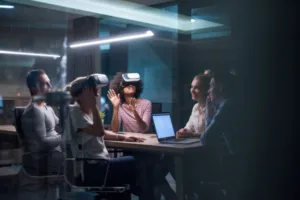In my continued series about VR as an educational tool in today’s industries, my last article focuses on current headaches in deploying VR and a few highly anticipated educational developments that will serve to make VR a more effective instructional tool.

These concerns and predictions are based on a recent webinar entitled “VR & AR/MR for Training & Education – What have we learned?”, a digital offering from (XR) Intelligence by Reuters Events. My previous articles in this series can be viewed here: Part 1 and Part 2. The speakers hailed from a variety of industries, including a children’s hospital, an industrial rentals firm, car sales/manufacturing, and B2B VR development, featuring Jeffrey Jacobson (Boston Children’s Hospital), Walter Davis (Aggreko), David Moreno (Virtualware), and Amanda Clarida (Volvo Trucks).
Current Headaches
It may be valuable to test your own awareness about VR-related challenges against the experiences of these VR-using companies. The webinar speakers quickly concurred that there are still a lot of rough patches in deploying VR in the enterprise setting. According to the speakers, the chief headaches facing enterprise VR include
Vendor lock-in. Many enterprises feel constrained by their past vendor choices. Companies can feel “locked in” when needing to pursue conversion to other, more robust, platforms. This is especially true for companies using external vendors to do their initial development, since companies don’t often have the in-house know-how to approach VR development. Once a VR instance has been developed using a specific vendor’s resources, then the “lock-in” issues” suddenly become relevant. A related problem presents itself when vendor VR constructs are not editable. And sometimes the “lock-in” is divergent in nature: for example, at the Children’s hospital, they have found themselves “locked in” to using four separate vendors, each highly particular and specialized. Jacobson confessed: “Each vendor has one particular advantage, such as specialty training for the nurse handing equipment to the doctor.”
In-house capabilities. The webinar’s speakers expressed the need for greater in-house expertise and a robust authoring platform to generate medical or other sims within a reasonable length of time [for internal just-in-time requests and proof of concept opportunities].
Filetype standards. Filetype standards represented a serious migraine for the webinar’s speakers, a wincing pain that also reverberates from vendor lock-in and the lack of in-house capabilities described above. Files increasingly seem to require some of conversion or optimization to run properly. Going back to the notion of “Use and Reuse” in Part 2 of this series, companies are not eager to make one-off VR instances, but are hoping for easier portability and conversion as training needs or content change.
Coming Attractions
At the end of the webinar, the speakers painted a brief but interesting picture of where this technology might be leading their organizations:
Jacobson (BCH) envisioned three distinct VR developments affecting the near future: First, he lamented that “a lot of use cases require controllers”, so Jacobson predicted that gesture control improvements will increasingly become a plus -one technology for immersive VR; second, he expects a surge in demand to create their own VR content within the hospital, while becoming less reliant on external developers; last, Jacobson shouted that 3D interfaces for VR are coming—to replace the uncomfortable and unlovely 2D interfaces that currently float in view—“and that will change everything”.
Walter (Aggreko) postulated that the convergence of AR/VR technologies in the near future would “open up new ways of training and collaboration” for their company.
Morena (Virtualware) suggested that the future of VR, from their perspective, would be to help corporations develop their own content. He added that we will need “performance, not consumer quality” headgear to ensure this happens.
Clarida (Volvo) suggested that the pathway forward involved some deliberative steps for their own training department: doing a good job listening to what internal Volvo training customers actually need; and finding the most cost effective solutions to get there, because “we can’t enjoy champagne when we have a beer budget.”
Some Concluding Thoughts
It appears, at first blush, that enterprise VR is still at the stage of pilots, tinkering, and experimentation. It’s also expensive, and thought industry leaders are constantly required to develop workarounds. Measurement is not a priority yet. We’re just not that far along, it seems. –Len Scrogan

